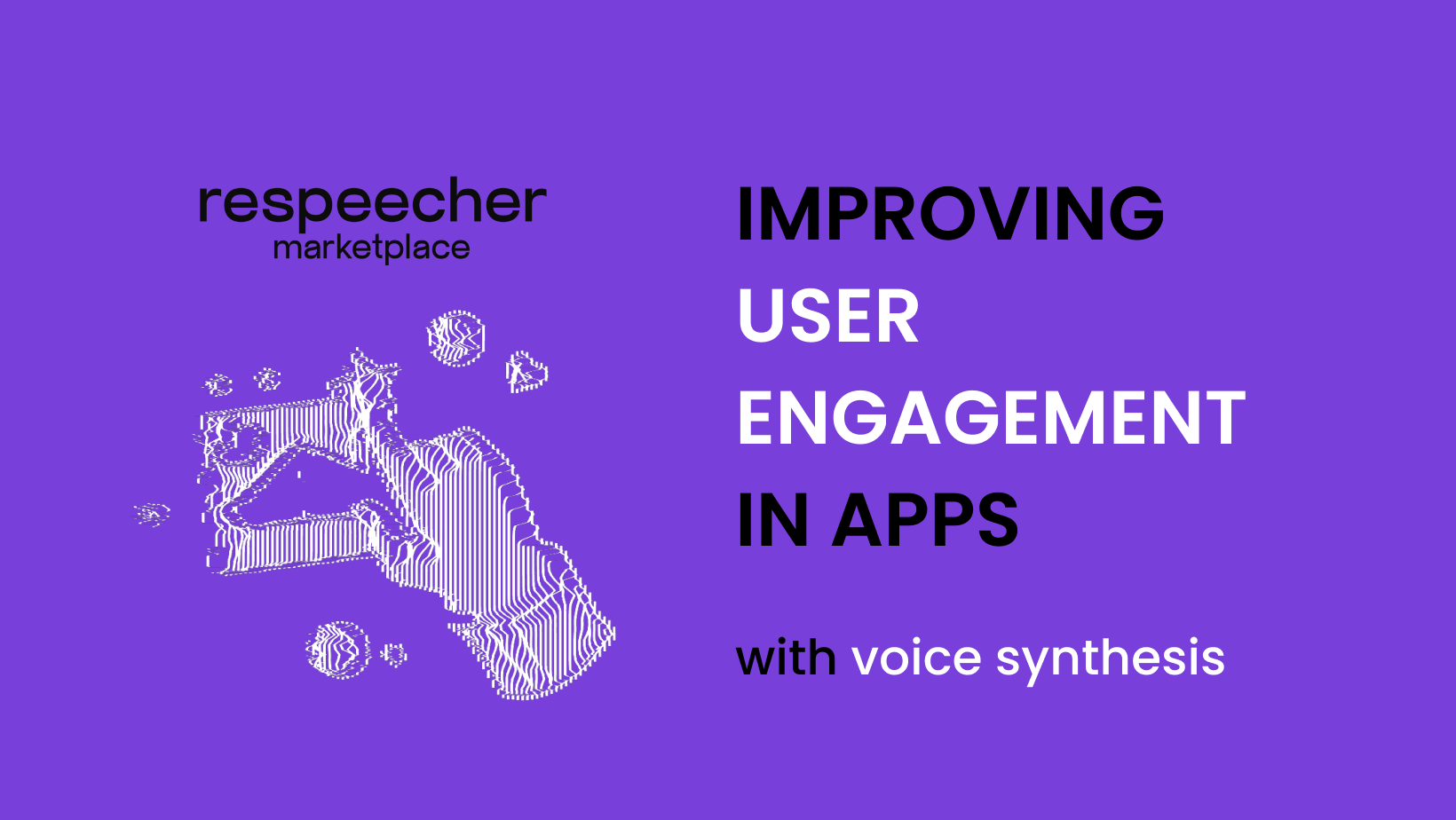How Voice Synthesis Can Improve User Engagement in Apps

With countless apps competing for users' attention, ensuring that users not only download but also actively interact with an app is crucial. High levels of user engagement lead to better retention rates, higher lifetime value, and more loyalty. Engaged users are likelier to make in-app purchases, provide valuable feedback, and advocate for the app.
Voice synthesis in apps can cater to diverse user needs, offering personalized interactions. As apps increasingly integrate voice synthesis, they enhance user engagement by making interactions more intuitive, immersive, and inclusive.
Basics of Voice Synthesis in Apps
Voice synthesis encompasses a range of technologies that generate human-like speech from text or other speech inputs. The two main types are text-to-speech (TTS) and speech-to-speech voice cloning.
-
Text-to-speech (TTS) technology converts written text into spoken words. It relies on natural language processing (NLP) and speech synthesis algorithms to produce natural and clear speech. TTS can be customized with different AI voices, languages, and intonations to suit various applications and user preferences.
-
Speech-to-speech cloning is an advanced form of voice synthesis that replicates a person's voice by analyzing their speech patterns and creating a digital model. Companies like Respeecher specialize in this area, allowing developers to create highly personalized and realistic voice AI user interactions. Respeecher's technology can replicate tone, pitch, and style nuances, enabling applications to offer highly tailored and engaging user experiences.
During app development, voice integration involves several technical considerations to ensure seamless functionality and an optimal user experience. Developers can integrate AI voice text-to-speech and voice cloning software through APIs of services that offer a range of voices and languages, enabling easy implementation and customization.
Also, real-time voice synthesis requires efficient processing to minimize latency. This is crucial for maintaining a smooth and responsive user experience, especially in interactive applications like virtual assistants, navigation, and gaming.
Enhancing Personalization with Voice Synthesis
Voice synthesis technology enables high customization, allowing apps to offer voice options that align with individual user preferences. This customization can significantly enhance personal engagement by making interactions more natural and tailored. Users can select from various voices that differ in gender, age, accent, and language, creating a more personalized and inclusive experience. Advanced voice AI synthesis systems also allow users to adjust the speaking rate, pitch, and intonation, further refining how the voice output sounds.
For instance, an app could provide different voice options to suit different contexts or user needs—such as a soothing voice for meditation apps or an energetic voice for fitness coaching. This level of customization helps create a more immersive and enjoyable user experience, encouraging users to engage more frequently and meaningfully with the app.
Virtual Assistants
Amazon Alexa and Google Assistant: These popular virtual assistants leverage voice synthesis to provide personalized interactions. Users can choose from different voice options and languages, allowing the assistants to cater to various preferences and cultural contexts. Additionally, these assistants learn user habits and preferences over time, offering more relevant and timely responses, which enhances user engagement.
Customer Service Bots
Banking and Finance Apps: Many financial institutions use voice synthesis in call centres and customer service bots to provide personalized assistance. For example, Capital One's Eno is a conversational AI that uses TTS to help users manage their accounts, track spending, and receive alerts. The bot can adapt responses based on user interactions, making the experience more tailored and efficient.
Healthcare Apps
Health and Wellness Platforms: Apps like Babylon Health use voice AI synthesis to provide personalized medical advice and reminders. Users can interact with the app through voice, making it easier to manage appointments and medication schedules and receive health tips. This personalized approach helps improve adherence to medical advice and overall user satisfaction.
Education and E-Learning
Language Learning Apps: Duolingo uses TTS to offer customized language lessons. Users can hear words and sentences in various accents and dialects, enhancing their learning experience by exposing them to diverse linguistic patterns. This customization makes learning more engaging and effective.
Entertainment Apps
Interactive Storytelling: Apps like Audible and interactive games use voice synthesis to deliver immersive storytelling experiences. Users can choose narrators with different voices and accents, enriching the narrative and captivating the content.
Improving Accessibility
Voice synthesis technology significantly enhances app accessibility, especially for people with disabilities such as visual impairments or reading difficulties. By converting text into spoken words, voice synthesis allows these users to interact with apps more easily and effectively. This technology can read out menus, instructions, notifications, and content, providing an inclusive experience that ensures no user is left behind.
Integrating voice synthesis in apps not only improves accessibility but also helps in meeting legal and ethical standards for inclusivity. Various regulations, such as the Americans with Disabilities Act (ADA) and the Web Content Accessibility Guidelines (WCAG), set forth criteria for making digital content accessible to all users, including those with disabilities. By implementing voice AI synthesis, app developers can comply with these standards, ensuring that their apps are accessible and usable by a broader audience. Compliance with these regulations is a legal obligation and a commitment to social responsibility and ethical app development.
Beyond regulatory compliance, integrating voice synthesis fosters a culture of inclusivity. It signals to users that the app is designed for their diverse needs. Inclusive design benefits everyone, not just those with disabilities.
Interactive Features Driven by Voice AI
Voice synthesis can transform user interfaces by making them more interactive and intuitive. Traditional graphical user interfaces (GUIs) rely heavily on visual elements and manual inputs, which can be limiting. By incorporating voice synthesis, developers can create voice user interfaces (VUIs), improving app engagement through natural, conversational interactions.
-
Dynamic Content Delivery: Users can interact with the app through voice commands, asking for updates, specific topics, or more details without needing to scroll or tap.
-
Interactive Tutorials and Guides: For example, a cooking app can provide step-by-step voice instructions, making it easier for users to follow recipes while cooking. Similarly, a fitness app can guide users through workouts with spoken instructions and motivational cues.
-
Personalized Feedback: Educational apps, for instance, can use TTS to read out correct answers, explain mistakes, and offer encouragement, creating a more engaging and supportive learning environment.
Voice-activated features can significantly simplify app navigation and task execution, increasing user satisfaction and retention. Users can open different app sections, search for content, and switch between tasks by simply speaking commands.
Also, voice-activated functions are particularly valuable when users need to be hands-free. For example, a driving app can use voice commands to set destinations, find nearby services, or get traffic updates, allowing drivers to stay focused on the road.
Cross-Language Support and Global Reach
Cross-language voice cloning allows apps to offer content and interactions in multiple languages. This capability is significant for apps looking to expand their reach and cater to diverse user bases. Voice synthesis technology can also adapt to regional accents, dialects, and cultural nuances, making interactions more relatable and engaging. This cultural relevance helps build trust and connection with users.
Duolingo
Duolingo, a popular language-learning app, uses TTS to provide spoken language exercises in numerous languages. The app offers interactive lessons where users can hear native pronunciations and practice speaking.
Google Translate
Google Translate uses advanced voice synthesis to translate spoken words and phrases into different languages. The app supports real-time voice translation, making it an invaluable tool for travelers and multicultural communication.
Waze
Waze, a community-driven navigation app, uses voice synthesis to offer driving directions and real-time traffic updates in various languages. Users can choose from different voice options to guide them in their native language.
Conclusion
Voice synthesis technology and AI voice cloning can potentially revolutionize apps with user engagement technologies by offering enhanced personalization, improved accessibility, and interactive features. By allowing users to customize voice options and experience tailored interactions, voice synthesis creates a more immersive and enjoyable user experience. It also makes apps more accessible to individuals with disabilities, ensuring inclusivity and compliance with accessibility standards.
Looking ahead, advancements in voice synthesis technology promise to further elevate its impact on app development. We can expect more natural and expressive synthetic voices, improved real-time processing capabilities, and deeper integration with artificial intelligence to create more engaging and personalized user experiences. Check out Respeecher’s capabilities to learn how to take advantage of this technology today.
FAQ
Using text or audio inputs, voice synthesis technology produces speech that sounds natural. Apps use it to create conversational voice user interfaces (VUIs), voice-activated features, and enrich user interaction with customizable AI voices and dynamic content delivery.
By converting text to speech, speech synthesis improves the usability of apps, which is beneficial for those with dyslexia or low vision. It will voice out the content, and the apps become more accessible and standards-compliant like ADA and WCAG.
By integrating AI voice cloning, apps can provide customizable AI voices that can be tailored for customized interactions. It facilitates user engagement technologies by rendering experiences more personalized and immersive, like speech-to-speech cloning or interactive tutorials.
Voice-activated features enhance user interaction with hands-free navigation and control. Applications become intuitive and interactive due to voice-activated features. They enhance user interaction by making it easy, like defining destination points for navigation or taking care of interactive tutorials.
While speech-to-speech cloning duplicates a person's voice by capturing their own distinctive characteristics when speaking, text-to-speech (TTS) converts written words into spoken words. Speech-to-speech cloning allows for more authentic, personalized messages in the user's preferred tone and style.
Cross-language voice cloning resizes speech into multiple languages, accents, and cultural idioms. It allows global apps to provide personalized interactions for users from different locations, maximizing app accessibility improvements.
Health, education, and customer support industries are assisted by voice synthesis in apps by offering personalized help, interactive tutorials, and more app accessibility improvements through voice-controlled functions.
Voice processing in real-time, low latency rates, and high quality of speech are challenging. Interactive voice interfaces and accessibility regulations should also be made compatible by the developers.
Glossary
Voice synthesis technology
AI voice cloning
Text-to-speech (TTS)
Speech-to-speech cloning
Cross-language voice cloning
Voice-activated features

- AI voice
- voice cloning software
- AI voices
- voice synthesizer
- AI voice generator
- Respeecher Voice Marketplace
- AI voice cloning
- text to speech AI
- AI speech synthesis
- AI generated voice
- AI voice over
- AI voice synthesizer
- AI speech generator
- voice ai
- AI speech
- realistic AI voice
- voice AI generator
- AI voice text to speech
- ai sound generator
- voice synthesis in apps
- voice AI user interaction
- app development voice integration
- cross-language voice cloning
- speech to speech voice cloning
- ai audio
- speech ai
- speech synthesis ai
- ai generator voice
- ai text to speech generator
- synthesis voice
- voice synthesis ai
- improving app engagement
- user engagement technologies





